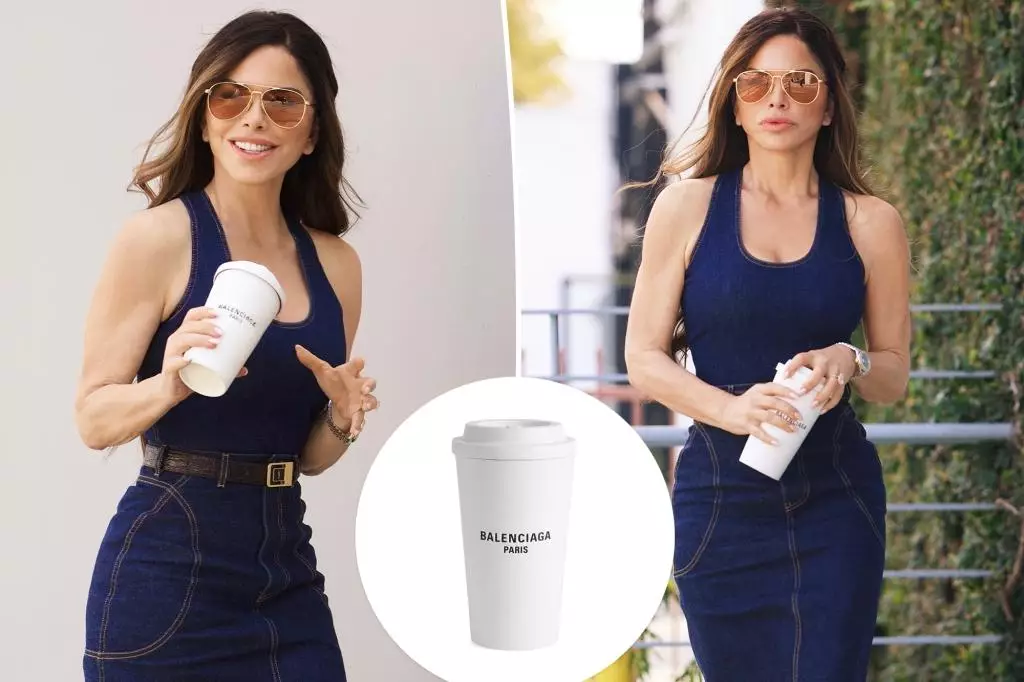Luxury fashion has seldom shied away from pushing boundaries—physically, conceptually, or financially. The recent unveil of the $5,750 Balenciaga handbag shaped like a coffee cup is a prime example of how far designers are willing to go to make a statement. Touted as the “9 AM Clutch,” this leather purse captures the essence of a common everyday object, elevating it to a status symbol that may confuse many consumers. This begs the question: when does fashion cross the line from avant-garde to absurd?
Resembling a porcelain coffee cup that typically sells for a mere $125, the clutch symbolizes a paradox within the fashion industry. It implores us to rethink value. Is it just a stylish handbag or is it an extreme exercise in consumerism? The choice of calfskin and the intricate detailing, including the visibly debossed Balenciaga logo, lends an air of sophistication. However, the question remains—what intrinsic value does this object hold beyond its fabric and branding? In a world grappling with economic disparities, it’s hard to ignore the extravagant pricing that labels such pieces as accessible only for the elite.
From Coffee to Closet: Fashion or Commentary?
Lauren Sánchez was spotted brandishing this showpiece as she left a meeting in California, complemented with a casual but trendy outfit. The clutch was paired with a denim halter dress that lent it a chic, effortless vibe, while brown pumps and aviators completed the look. For Sanchez, who has now become a household name given her affiliation with billionaire Jeff Bezos, it seems that a pricey accessory fits right into her lifestyle. However, one can’t help but wonder if such a purse serves as genuine fashion or as a commentary on wealth and celebrity.
Moreover, Sánchez’s sartorial choice raises questions about the role of influencers and celebrities in shaping consumer habits. Is she merely a fan of bold fashion, or does she feel pressured to continue the narrative of opulence that surrounds her? Undoubtedly, the spotlight on public figures like her creates a gravitational pull for more consumers to chase after similar extravagant statements for themselves. The pendulum swings between inspiration and aspiration—consumers are forever trapped in the chase for high-end items that redefine their status, regardless of their bank account balance.
Celebrity Nuptials and the Scaling of Lavishness
The upcoming wedding between Sánchez and Bezos is poised to escalate notions of extravagance. The celebration promises to attract an A-list guest list: Oprah Winfrey, Kim Kardashian, and potentially Donald Trump. The couple reportedly aims to create an unforgettable experience for their guests, a venture that echoes the sentiments of a world where money talks louder than ever. The involvement of Bezos’ massive $500 million yacht, Koru, in the wedding preparations introduces a further level of spectacle—and several layers of privilege one may argue should be reserved for personal experiences rather than public shows of wealth.
Prices at elite hotels in Venice shoot up to a staggering $3,200 per night during the wedding festivities, with some accommodations tantalizingly closer to the tenfold mark. This sheer scale of spending puts a firm spotlight on the rampant inequities present in society today. The message sent out is one of detachment; as the rich indulge in breathtaking indulgences, they can easily forget about those living paycheck to paycheck.
Furthermore, Sánchez’s choice of an Oscar de la Renta gown, crafted with guidance from Vogue’s own Anna Wintour, only cements the connection between high fashion and privilege. It’s a tale as old as time—while the elite parade in their bespoke garments and prized accessories, the everyday consumer is left longing, chasing a dream that remains perpetually out of reach.
The Fashion Dilemma: Artifact or Investment?
In reviewing the frenzy surrounding high-octane fashion items, we must confront the underlying dilemma: are such accessories mere artifacts of luxury, or do they hold some form of investment quality? The Balenciaga 9 AM Clutch doesn’t just prompt buyers to consider functionality; it leads them to confront the implications of their purchases. Is it worth spending thousands for uniqueness that might only serve as an excellent conversation starter at gatherings of the affluent?
Ultimately, as we navigate this landscape paved with luxury and trend, one can argue our choices reflect our self-worth. The challenge lies in discerning when an item becomes an update to one’s appearance and when it slips into the realm of spectacle. As consumers continue to grapple with this balancing act, the allure of high-end fashion remains a game of individual interpretation, values, and aspirations.

